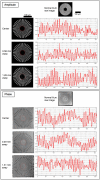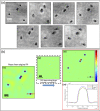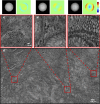Wide-field Fourier ptychographic microscopy using laser illumination source
- PMID: 27896016
- PMCID: PMC5119616
- DOI: 10.1364/BOE.7.004787
Wide-field Fourier ptychographic microscopy using laser illumination source
Abstract
Fourier ptychographic (FP) microscopy is a coherent imaging method that can synthesize an image with a higher bandwidth using multiple low-bandwidth images captured at different spatial frequency regions. The method's demand for multiple images drives the need for a brighter illumination scheme and a high-frame-rate camera for a faster acquisition. We report the use of a guided laser beam as an illumination source for an FP microscope. It uses a mirror array and a 2-dimensional scanning Galvo mirror system to provide a sample with plane-wave illuminations at diverse incidence angles. The use of a laser presents speckles in the image capturing process due to reflections between glass surfaces in the system. They appear as slowly varying background fluctuations in the final reconstructed image. We are able to mitigate these artifacts by including a phase image obtained by differential phase contrast (DPC) deconvolution in the FP algorithm. We use a 1-Watt laser configured to provide a collimated beam with 150 mW of power and beam diameter of 1 cm to allow for the total capturing time of 0.96 seconds for 96 raw FPM input images in our system, with the camera sensor's frame rate being the bottleneck for speed. We demonstrate a factor of 4 resolution improvement using a 0.1 NA objective lens over the full camera field-of-view of 2.7 mm by 1.5 mm.
Keywords: (070.0070) Fourier optics and signal processing; (110.1758) Computational imaging; (180.0180) Microscopy.
Figures








References
-
- Hegerl R., Hoppe W., “Dynamic theory of crystal structure analysis by electron diffraction in the inhomogeneous primary radiation wave field,” Ber. Bunsenges. Phys. Chem. 74(11), 1148–1154 (1970).10.1002/bbpc.19700741112 - DOI
Grants and funding
LinkOut - more resources
Full Text Sources
Other Literature Sources
